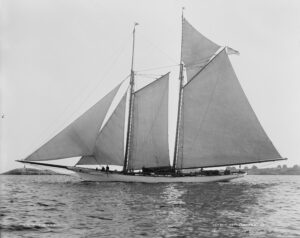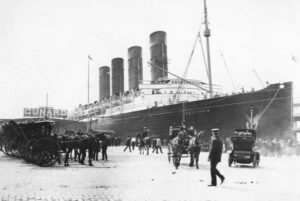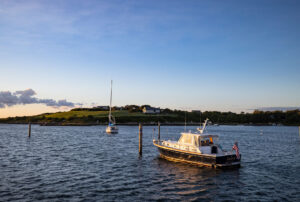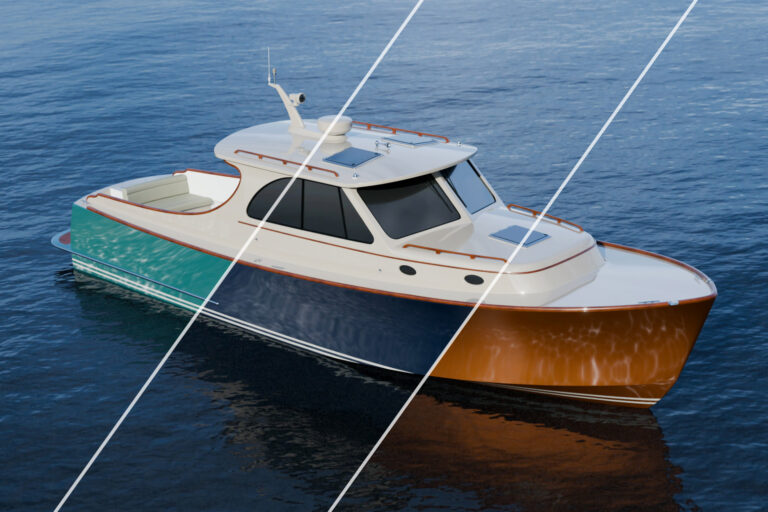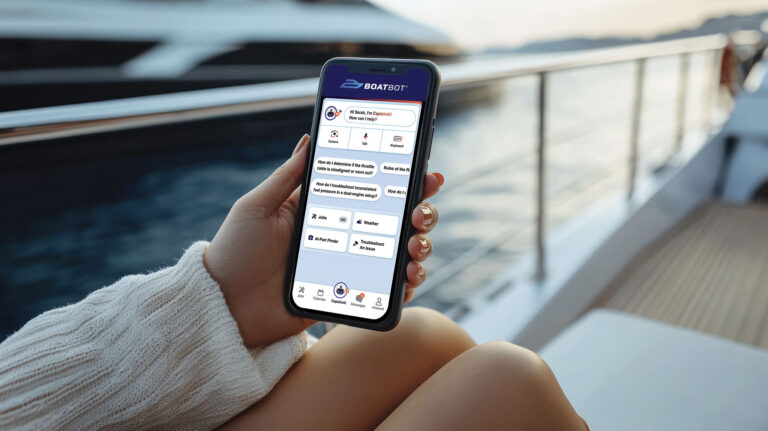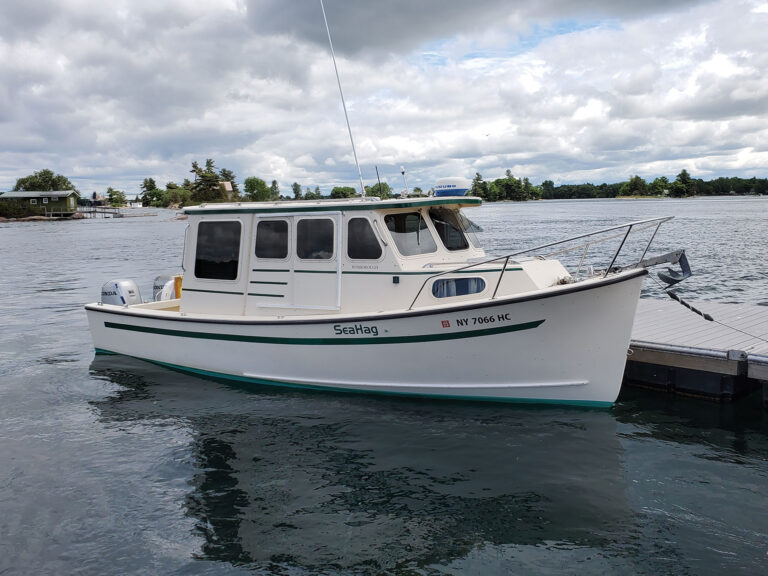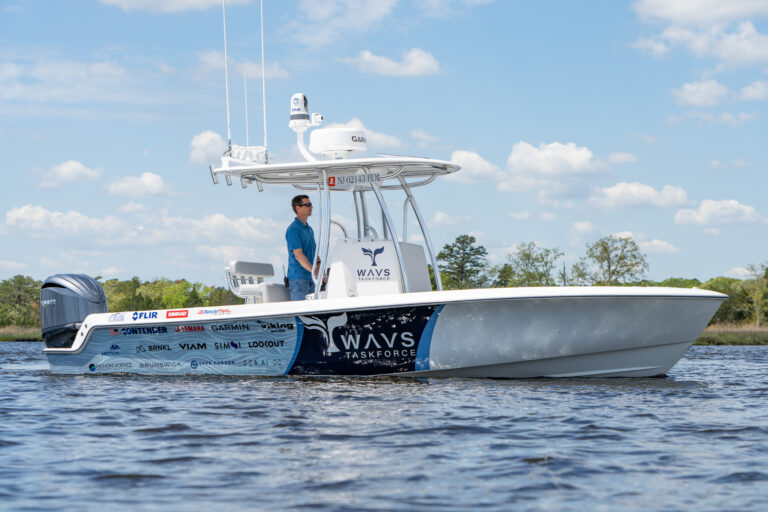David Marlow has been checking struggling boat companies for signs of a pulse and buying some that look as if they can be revived and folded into the growing family of Marlow yards and companies that build, service and distribute yachts.

Marlow’s most recent acquisitions: the operating assets of Hunter Marine Corp. — one of North America’s largest sailboat builders — and “selected assets” of powerboat builders Mainship Corp. and Luhrs Corp. Marlow Acquisitions LLC bought the brands July 10 with the approval of U.S. Bankruptcy Court in New Jersey, where their parent company, Morgan Industries Corp., filed April 30 for Chapter 11 bankruptcy protection.
Mainship and Luhrs had ceased production in January. Hunter, which also builds boats for Gemini Catamarans, has continued to operate at its Alachua, Fla., plant.
Marlow builds yachts in China, but he promised that he won’t ship any Hunter-Mainship-Luhrs boatbuilding jobs abroad. To persuade skeptics that the acquisitions aren’t a gambit to move the manufacturing operations to his China yard, he has leased the Hunter plant in Alachua to continue building there while he decides whether he needs to build another factory or buy an existing one in the United States to house them.
Meanwhile, Marlow says he expects to take advantage of some synergies between his U.S. and Asian yards. He’ll be importing timber from his China mill, as well as some exotic metalworking, hatches, ports and other components from the China yard, which makes much of its own hardware. He also plans to bring advanced composites technology that he developed in China back to America — what he calls “our version of reverse engineering.” He says he will focus for now on Hunter and Mainship, taking them “to the next level,” and will maintain Hunter’s relationship with Gemini.
Marlow owns a service yard in Palmetto, Fla., and builds a variety of boats — expedition yachts, express cruisers, tenders and dinghies — at Norsemen-Marlow Shipyard in Xiamen, China. He opened the Chinese shipyard in 2002 as a showcase of high-tech boatbuilding and environmental responsibility and has won industry “green boatyard” and innovation awards for it. He has built more than 100 yachts there — Explorer and Voyager passagemakers, Prowler express cruisers, Sprite tenders and Gypsy classic wooden dinghies.
His ‘life’s work’

At 69, Marlow, chairman of Palmetto, Fla.-based Marlow Yachts (www.marlowyachts.com), describes himself as “high-mileage but in very good condition,” and he moves so fast that just catching up with him to talk is a big undertaking. Walking the grounds of Miami’s 126-year-old Merrill-Stevens Drydock Co., which he bought in the summer of 2011 as another reclamation project, the can-do boatbuilder, yard operator and self-described “river rat” is brimming with ideas for kindling a renaissance of the historic yard on the Miami River — Miami’s river. “This is an iconic dowager that needs to be put back in shape,” he says. “The first order of business is to make the place presentable.”
That means cleaning up the yard, making it safe, putting in greenery and fixing up buildings. One of his first projects: taking down the tall chain-link fences topped with concertina wire and putting in architectural aluminum fencing. “I don’t like the Stalag 13 look,” he says, glancing at the barbed wire — a reference to the German World War II POW camp.
The aluminum fencing is up — in Marlow colors of oyster white and flag blue — and crews have carted away more than 1,200 cubic yards of trash and debris, poured more than 18,000 square feet of new concrete, installed a new fire system, repaired or replaced roofs, and rebuilt inoperative machinery. Landscaping is ongoing. “We are on target to complete [the rehab] approximately July 2013 as planned,” he says.
Marlow says he wants the yard to be a credit to his customers, an enhancement to the community and a pleasant workplace for his employees. He says this with the finality of one who is accustomed to making things happen. He expects to bring the same spirit of stewardship and entrepreneurial verve to the 5.6-acre Miami yard — now called Marlow Merrill Stevens — that he brought to the Xiamen project. He wants to turn it into a park-like place, a gleaming gem on a river that the city of Miami plans to rehabilitate by upgrading historic neighborhoods, setting aside riverfront for parks and pathways and encouraging marine businesses to put out their shingle. Marlow one day will build boats there. Meanwhile, he says, the yard has performed more than $10 million in retail service since June 2011, from major shipwright work to bottom painting.
Marlow doesn’t think small. He bought the Merrill-Stevens yard in June 2011 for a reported $6.6 million from the Coconut Grove Bank, which had held the mortgage on the property and taken title to it a few months earlier. Former owners Hugh and Carole Shields Westbrook, yacht owners themselves and founders of Vitas Healthcare Corp., bought the yard from the Merrill family in 2004 for $10 million. They planned to offer a full menu of megayacht services — charter and management, brokerage, crew placement, regulatory consultation — and upgrade the yard to service yachts to 250 feet. That plan foundered in the recession, as even affluent megayacht owners curtailed their yachting and lenders became more cautious.
Marlow believes he can succeed where the Westbrooks did not. “A lot of people are going to say, ‘He’s nothing but a rich guy coming to play in the boat business,’ “ Marlow says.“ ‘How long will he last?’ “
Marlow says boats have been his “passion” and his “life’s work” for 43 years, even longer if you count his reluctant trips into the Florida swamps with his boatbuilder dad to hunt up pieces of wood for a keel or stem for the fishing smacks — seine, stopnet and grouper boats — the elder Marlow built. “I went to play in the woods, not to work,” he says. His mind then was far away from building boats.
Yet at age 12 he made his first solo foray as an entrepreneur, building canoes of corrugated tin salvaged from chicken coops, caulking them with pine tar and charging his friends $10 to join his canoe club on Frog Creek in Palmetto. “It was a wonderful experience,” he says.
Heeding the advice of his father, he built a good canoe. His dad, an Irishman who married a Cherokee Indian — Marlow’s mom, who died when he was 5 — used to tell him, “Money’s a way to keep score, but you don’t worry about it. You do it the right way. Start with a good design, use good materials and craft the boat like an artisan.”
That’s not to say Marlow isn’t also a very shrewd and focused businessman. An advocate of his own brand of vertical integration, Marlow believes his management team can weave efficiencies, technology, craftsmanship and components from his Asia plant into Hunter-Mainship’s U.S. operations to create a more competitive business model, one that will challenge the generally “lackadaisical approach” of U.S. industry to foreign competition.
The boatbuilder

Marlow has been taking stock of the Miami yard, its market and the South Florida business environment to see what direction it should go. He has some ideas. Marlow Merrill Stevens’ north yard has a 500-ton Synchrolift and a 500-ton railway that he plans to upgrade to 750 tons; the south yard’s 100-metric-ton Travelift will be replaced with a 220-ton lift. With the upgrades, he says, the operation will be able to haul 115-footers on the south side, 170- to 180-footers on the north side.
He says he’ll seek service contracts with the Coast Guard and other government agencies that now contract with a yard in Jacksonville. He’ll bid for repair, service and restoration work on yachts small, large and super-sized. When the time is right, the yard probably will build boats, too. “Sail or power makes little difference, as we have built both,” Marlow says. “I suspect special-purpose power, where a need or desire exists to have something that may be difficult to buy or attain in the market. That said, we have personnel who can construct anything of any materials, so I suppose, to quote George Herbert Walker Bush, ‘Stay tuned.’ “
Marlow the boatbuilder has been rocking the long-range cruiser market since 2001. That’s when he came out of retirement in Maine to build a 65-foot passagemaker — the Explorer — after successful careers in houseboat sales and rentals on Florida’s West Coast, as an operator of several boatyards, and as owner of one of the world’s largest dealers for Pacemaker, Egg Harbor and Grand Banks. First built in Taiwan and now in China, the Explorer 65 and later models from 53 to 97 feet, his slower and longer-range Voyager 76 and his smaller lines — the 37-foot Prowler express cruiser/picnic yacht, 15-foot Sprite and 14-foot Gypsy — all reflect Marlow’s personality.
He doesn’t fit easily into a single genre. Marlow likes boats of all kinds as long as they’re interesting. He’s a techie, but he’s also an artist and perfectionist. The Rybovich brothers, Tommy, John and Amel — premier builders of sportfishing yachts for four decades after World War II — were his guiding lights. As a teen, Marlow would go to the Rybovichs’ West Palm Beach yard with his brother Grady Marlow, a sportfish captain, and see Tommy come down to the shop after dinner and mark up hulls in various stages of completion, leaving “love notes” to his workers to fix the tiniest blemishes. “The Rybovichs turned out perfection, art,” Marlow says. “They were committed to an absolutely unrelenting pursuit to give customers what they wanted.”
Besides exquisite craftsmanship and joinery, Marlow says he aims for a boat that is light, strong and efficient, with a low center of buoyancy that is carefully determined and maintained — without adding ballast, if possible — as the boat comes together and systems and heavy equipment are installed. “In a powerboat, [center of buoyancy] is the holy grail and the beginning point of everything I draw,” he says. “If you’re going to build a really fine boat to go to sea in, you can’t be frivolous about this. This is very foundational, I think.”
Marlow uses composite construction — Kevlar inner and outer skins with closed-cell foam between — and a proprietary vacuum bag resin-infusion process that saves building time while strengthening the hull and saving weight. The structural design is monocoque, which eliminates interior bulkheads and uses the hull skin as a frame — similar to an aircraft fuselage — again, to save weight, but also to add interior space. Most of a Marlow yacht is made from just three molds, compared with many more for some yachts, which dramatically cuts the number of molded parts and seams and eliminates the problem of adjacent components rubbing against each other in heavy seas.
Marlow says that, over time, he has strengthened and lightened his boats, but from day one — the Explorer 65 and forward — he has used a pair of skeg-like foils to encapsulate the shafts and bearings and improve hull efficiency. The foils eliminate drag from the struts, protect running gear and reshape the water as it flows by, reducing the stern wave, increasing speed, dampening roll and enabling the hull to track better. He says the foils direct clean water to the prop so it works more efficiently.
A lightning rod for controversy, Marlow says the future of boatbuilding belongs to the high-tech innovators and he includes himself among them. His latest offering, the Voyager series, bucks the conventional wisdom that a truly long-range passagemaker must ride a slow displacement hull. “Full-displacement shapes are not the most economical or seaworthy shapes available, despite the all-knowing dock lore bought and sold,” Marlow says.
He says the semidisplacement boat is a little heavier and has a slightly narrower beam and deeper midsection than the Explorers but is still light at 115,000 pounds. Powered by twin 776-hp Caterpillar diesels and ZF pods, it can cruise 3,900 miles at 10 knots with 4,500 gallons of fuel. Marlow says the yacht is safe, fast — 12-knot cruise, 19 top — and certified for unrestricted navigation (assigned to a yacht intended to operate in any area and any time of year). The yacht has a bulbous bow, and stability is achieved by keeping the center of gravity low and through the use of stabilizers, as conditions dictate. These stabilizers include 400 gallons (3,440 pounds) of seawater ballast, hydraulic stabilizers and stabilizing plates — “birds”— that drag under water from booms and are deployed at the push of a button.
“Vagabundo, a 76-foot Marlow Voyager, makes the crossing from Fort Lauderdale to Bermuda at 18 knots, whereas a normal displacement yacht of similar size could possibly average 8 knots under reasonable conditions,” he says. “The same Vagabundo can travel at 9 knots from Fort Lauderdale to Greenland with far more than ample fuel reserves, whereas a displacement 76-foot yacht would be forced to reduce speed to a mind-numbing pace of 6-plus knots maximum to arrive at all, with very little reserve upon arrival.”
Rentals to sailracing

Spend a couple of hours with Marlow and the conversation bounces around like a pinball from hull stability to his hardscrabble childhood to his wide and varied interests, pursuits and adventures. One of a dozen children, Marlow lost his mother at age 5 while living in Apalachicola, Fla. When she died, his dad packed up the brood and together they climbed aboard a Greyhound bus, headed for Frog Creek in Palmetto, where the patriarch took up building wooden commercial fishing boats. “He had great skill with his hands,” Marlow recalls. “He was an artisan.”
Yachtsmen started noticing his boats and the quality of the carpentry, and doctors and lawyers soon were asking him to build them pleasure boats. His dad died — virtually penniless — when Marlow was just 14 after a boat he was building fell on him (and his young son), leaving the elder Marlow disabled. The boy came through it OK. The family “scattered like the wind” after his dad died. Marlow lived for a year with an older brother, a preacher, then hit the road. He lived for a time in Montana and wound up in the Yucatan, working on shrimp boats and tugs.
His wanderlust years behind him, the young man returned to his home waters and in 1965 persuaded a bank loan committee that there were profits to be made renting houseboats. He secured a $50,000 line of credit, $20,000 of which went to buy a pair of Drift-R-Cruz houseboats built by Miami’s Thunderbird Products. Within three years, the driven entrepreneur owned a fleet of 21 rental houseboats, a houseboat distribution company and a piece of a houseboat manufacturing business.
By 1972, Marlow had eased out of houseboats and into the sale of sportfishermen, becoming the world’s largest Pacemaker dealer, the second-largest Egg Harbor dealer, and later one of Grand Banks’ leading dealers. (He still does Grand Banks refits at his Palmetto yard.) Meanwhile, he had started buying boatyards on Florida’s Gulf Coast, specializing in upgrading them, tightening management and spiffing up the service. Not content just to fix boats, he also started taking on custom building jobs. “I designed and we built a few high-performance sportfishermen for avid and wealthy sport fishermen with special needs that could not be answered by production factories in the mid-’70s,” he says.
His fishing boats were light, strong and built of what at the time were advanced cored materials. One of his builds was a 30-foot powerboat, Destiny, that topped out at 41 knots; voyaged regularly from Sarasota, Fla., to Port Antonio, Jamaica and Cozumel, Mexico; and consistently won big-money tournaments for its businessman-owner. The boat was small, agile, seaworthy and could land a big fish quickly. Marlow says these custom jobs gave him the chance to work with composites and fast hull forms — and build oceangoing boats that were light, strong and speedy.
In 1981 he took a side road into sailboat racing, but he says it was an important road for him as a builder. He became a dealer in S2 performance sailboats and its 7.9 model, a perennial winner in Midget Ocean Racing Club competition. Marlow says he immersed himself in sailing and racing, learning about loads, drag, waterplanes and how heel angles and roll affect water flow and draft. Marlow raced in the Southern Ocean Racing Conference, campaigning an Ed Dubois-designed 43-footer, Mandrake, that won 11 of 13 races. In 1987 he closed out his racing career sailing a 40-foot One Tonner — now named Gunsmoke — in the Admiral’s Cup. “We built her at Christchurch, New Zealand, of exotic materials and innovative methods of early resin infusion,” he says. “The hull weight, minus deck and keel, was 680 pounds at 40-foot length, with the deck at 455 pounds.”
Retired, for a time

Marlow retired from the boating business after the Admiral’s Cup. “I still love to sail,” he says. Restless, he came out of retirement in 1993 to build his Palmetto yard on Snead Island, on the site of a junkyard for dredge equipment. Marlow says he and his crew hauled 44 dump truck loads of garbage off the property, not including sunken barges and carcasses of fiberglass boats. Today the yard is a lush oasis on the Manatee River. “It makes a wonderful place to work, though it is easy to daydream looking out at the basin,” he says.
A few years later, after working with Marblehead, Mass., yacht designer Doug Zurn to refine the drawings of the first Explorer, Marlow went to China and built the yard to build his yachts. Among its features: underground rock-and-sand beds that filter runoff before it goes into 300,000-gallon cisterns to irrigate the yard’s orchards and landscaping; granite walls extending 36 inches below the ground to prevent pollution from leaving the property; water traps in the factory to capture airborne dust; an apartment complex, cafeteria, recreation center and training facility for its 600 workers; and a teak plantation.
Managing the China and Palmetto yards, and now reviving the Miami yard and Hunter-Mainship-Luhrs, promises to be a handful, but Marlow thrives on four hours of sleep a night and adrenalin. “I really, really get a grin seeing formerly dormant things come alive,” he says. “They’re not dead.”
The deaths of Marlow’s mother and father were hard blows, but he counts himself lucky to have gotten some breaks later in life and gathered a talented and hard-working team around him who “don’t work for me but with me” — his musketeers. “My relationships tend to be very long-term,” he says. “That’s the personal nature of this business.”
One of his musketeers is George Dragonov III, a Bulgarian he found sleeping under a tree outside his house on Whitaker Bayou in Palmetto one morning in 1967. Standing 6 feet, 7 inches, thin as a rail and bearded, Dragonov — a master craftsman who had studied the work of the great wooden-boat builders — was looking for work at Marlow’s yard. Marlow calls Dragonov the “gentle giant with hands of a brain surgeon and a mind of Da Vinci.” He still works for Marlow at his Palmetto yard. Another is Don Curreli, who grew up an orphan in Thomasville, Ga., and later became a successful contractor. Marlow and Dragonov built a boat for him, and he’s been part of the Marlow team ever since. He’s a “jack of all trades and a master of all of them,” Marlow says.
The third musketeer is Michael Huang, a naval architect and engineer, the first employee Marlow hired at the China yard before starting tooling for the first 65 and now his chief operating officer there. He is, as Marlow considers himself, a “freethinker,” a problem-solver and a savvy businessman.
As Marlow has taken on projects such as the Chinese yard, the Merrill-Stevens overhaul, the Hunter acquisitions and the new line of Explorer and Voyager yachts that cut against conventional thinking, he realizes that his methods and undertakings often are unorthodox. For Marlow, that’s what keeps life interesting.
“We’re not Toyota,” he says. “Our management doesn’t fit the mold of what Harvard would tell you. If I tried to impose my business norms at Harvard, they would throw me out.”
October 2012 issue.


